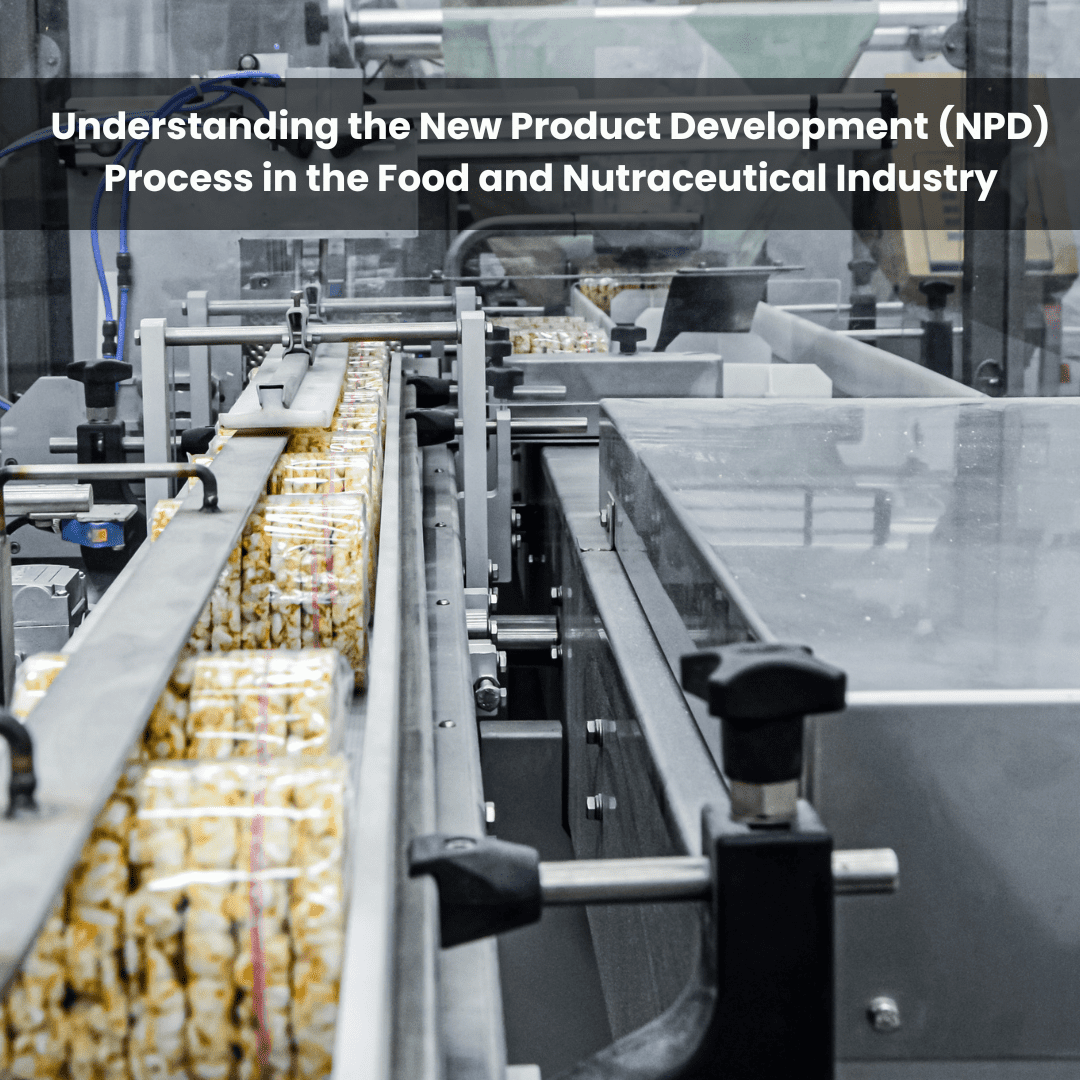e. Sensory Evaluation & Stability Testing
Pilot prototypes will have undergone extensive sensory evaluation, with taste panels, a texture analysis, and shelf-life testing under a variety of storage situations to ensure product stability over time.

The process of introducing a New product development (NPD) in the food industry involves a systematic process of developing, testing, and marketing new food products or improved foods to meet consumer needs and market demand. New product development (NPD) typically involves ideation, ingredient selection, formula development, sensory evaluation, food testing, compliance and marketing plan.
Product development is a future-oriented activity. It is an attempt to predict what the marketplace will need and convert that into innovative products.
New Product Development (NPD) is essential for fulfilling consumer needs, innovating, and adhering to regulations in the fast-changing food and nutraceutical sectors. Whether it’s releasing a functional beverage with adaptogens or a clean-label snack appealing to the health theta audience, New Product Development is the connection between an idea and an actual product that can be sold in the market. This article will discuss food and nutraceutical product development, the types of products involved, factors for success, hurdles to overcome, and industry trends serving as the impetus for future development. [1]
The new product development journey is divided into phases, each one employed strategically to safeguard the viability, safety, and readiness of the product for the market.
Organizations take a variety of approaches to derive new ideas. Oftentimes, the company can incorporate input from many aspects of the firm, but in many cases the marketing team, along with some contribution from R&D and consumer feedback, led the ideation process. Some companies take the idea of benchmarking to a new level and use the planning of successful concepts by competitors with limited emphasis on developing new ideas.
This phase starts with the identification of the innovation opportunity via market research, health trends, and gaps in the portfolio. There are many drivers, such as suggested updates in recipes and alternative ingredients, shifts in food habits, culture, technology innovations in food, processing, and machinery.
The primary purpose at this stage is to discard any impractical or unviable ideas before we commit significant time and resources. This means we need to critically assess whether the proposed product provides real value to the target market.
Promising ideas are developed into organized product concepts about target audiences, the expected benefits of the product, what you claim the product to do, and the sensory characteristics of the product including how it works. Risk analysis, SWOT analysis and scoring models are some examples of analytical tools, used to evaluate and rank the product concepts that seem to have the greatest likelihood of success.
At this point, ideas are assessed for technical and commercial feasibility, factoring in considerations including ingredient availability, cost effectiveness, safety, and alignment with consumer needs, as well as initial financial modelling and some regulatory analysis.
To provide the broadest picture possible, a cross-functional team made up of R&D, regulatory, finance, and production is formed. This allows any potential issues with regards to regulations, technology and budget to be identified and addressed early in the development cycle.
This phase confirms the company’s investment in the new product with a formal business plan, generally with significant market research. Product developers create initial formulations with the selected ingredients, while balancing nutrition, taste, texture, and shelf stability. Product functionality, sensory testing, and ingredient sourcing all take place during this stage. Preliminary pricing is also established based on the formulation and positioning.
Pilot prototypes will have undergone extensive sensory evaluation, with taste panels, a texture analysis, and shelf-life testing under a variety of storage situations to ensure product stability over time.

At this stage, engagement with potential customers is extremely important. Feedback regarding taste, appearance, and overall appeal is gathered through sensory evaluations and focus groups. This feedback aids in identifying necessary modifications that may enhance consumer approval prior to the product’s launch in the market.
Informed by insights from consumer testing, refinements to the product are performed. This may involve reformulation or packaging adjustments to ensure the final product meets market expectations and complies with safety standards. Real-time feedback may also guide improvements in quality and help ensure adherence to food safety regulations.
Once a formulation has been decided, everything needs to be compliant with local and international food safety regulations. Produced the catalogue sheet of permitted ingredients, allowed health claims, allergen declarations, nutritional values etc. Regulatory Dockets may need to be prepared for relevant certification bodies (i.e. FSSAI in India, FDA in the USA, EFSA in the EU).
Lab scale formulations that have been validated to produce approved prototypes may result in pilot scale and production trials. Emphasis will involve, but not be limited to, consistency of processes, reproducibility of batches, and documenting results and adjustments to processes. Modification of any formulations because of scale-up will need to be revalidated.
The stage of commercialization is shifting from development to market launch. This means finalizing the design of your packaging, branding, pricing and go to market plans. The marketing teams will be responsible for ensuring product positioning aligns with distribution channels and how they will engage with consumers.
At the same time, you will finalize your manufacturing processes with production scale and quality assurance. You will also need your strategy, messaging, promotional program and customer support systems in place to support your entry into the market and ultimately overall product performance. [2] [3]
“At Food Research Lab, we follow a customized 9-stage New Product Development process designed specifically for functional foods and nutraceuticals. This framework aligns with industry best practices and emphasizes scientific formulation, regulatory compliance, sensory evaluation, and commercialization support, ensuring a streamlined path from concept to market.”
The classification applies broadly to both nutraceutical product development and food innovation, helping companies better target formulation and marketing strategies. New product development or product development is common in the food and nutraceutical industry through the following pathways:
Success in New Product Development depends on the following:
The new product development (NPD) process is not without supply chain complications:
The food regulatory bodies have strict regulations regarding ingredient usage, health claims, and labeling. In India, the FSSAI governs food safety, while multinational companies must align with USFDA, EFSA, and other authorities. Non-compliance can result in delays, penalties, or product recalls, so it is very important to have regulatory expertise in the early stages of developing a product. [6]
Recent innovations are determined by:
The New Product Development process is a science-based and market-sensitive process that creates effective, legal and consumer acceptable products out of creative ideas. A well-formulated new product development process will accelerate development timelines and help assure product success and brand reputation. As health trends evolve and regulations become strict (e.g., with vitamins and supplements), investing in a new product development process and methodologies will become vital for businesses to flourish in the competitive food and nutraceutical environment.
Interested in taking your product idea to marketable innovation? Connect with Food Research Lab (FRL) to leverage our completely new product development for completely new product development services—scientific formulation, sensory work, regulatory support & scale-up.

Food Research Lab strives for excellence in new Food, Beverage and Nutraceutical Product Research and Development by offering cutting edge scientific analysis and expertise.
